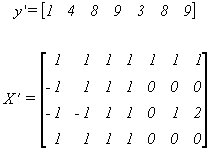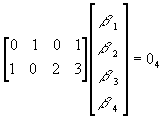
Temple University
Department of Economics
Econometrics I
Ordinary Least Squares

you have collected the following data

a. Are the columns of X orthogonal; some or all pairs?
b. Compute X'X.
c. Compute X'y.
d. Compute [X'X]-1
e. Compute the least squares estimates b=[X'X]-1X'y.
f. Compute the angle between y and the span of X.
h. Compute the least squares residuals.
i. Compute the sum of squared residuals, divide the result by the appropriate number of degrees of freedom. Call the result the estimate of the error variance, s2.
j. What is your estimate of the variance of b2?
k. What is your estimate of the covariance of b2 and b3?
l. Using the first, fourth and fifth observations, plot x1, x2, x3, and x22 in 3-space.
m. What is the dimension of the space spanned by these four "independent" variables?
n. Briefly discuss the various meanings of independent as implied in the execution of this problem.
o. Now plot the first, fourth and fifth observation on y in the same diagram you did above. Would the coefficient estimates you get from the projection of y on the space spanned by the independent variables in this diagram be the same as those you obtained in part e? Why or why not?
p. Using your answers to parts d and g, is b2 different from zero?
q. Find the restricted least squares estimator subject to the restrictions
